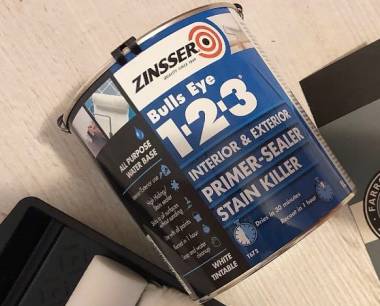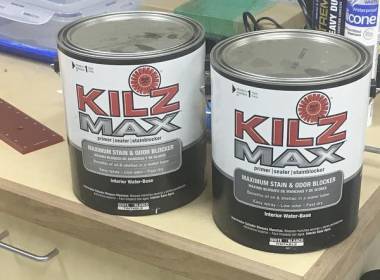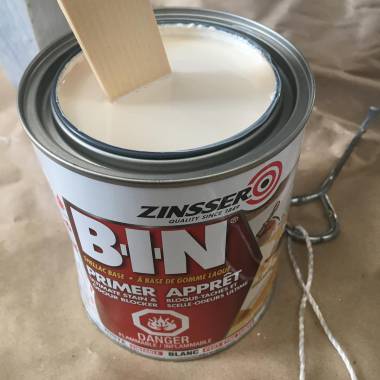Choosing a high-quality primer is one of the key components in achieving a smooth, beautiful, long-lasting paint job. Primer seals the surface, so your drywall doesn’t drink in coat after coat of expensive paint, and it can help you achieve a flawless finish for any project, whether you’re refinishing furniture, repainting cabinets, or painting outdoor woodwork.
It’s never a good idea to skip the paint primer, even if you’re painting over existing coats of gloss or semi-gloss paint. When you’re comparing primers, two names will likely stand out as competitors: Kilz vs. Zinsser.
Read on to find out what benefits or drawbacks each of these top primers has to offer.
Zinsser vs. Kilz Primer: Variety of products
First, let’s clarify which products we’re comparing. Both Kilz and Zinsser offer a variety of options.
One stellar offering from Zinsser is their Bulls Eye 1-2-3 Interior/Exterior Water-Based Primer. From Kilz, you have the Kilz Premium High-Hide Stain-Blocking Interior/Exterior Primer, which is also water-based. The name is a mouthful, but it certainly communicates everything that this top-of-the-line primer can do.

Kilz Primer
Kilz also offers an Original Primer formula and an Adhesion Primer variety that is great for tough-to-paint surfaces. From Zinsser, you can obtain the B-I-N Shellac-Based Primer, which locks in difficult odors from fire smoke, tobacco smoke, or pets.
Both brands supply homeowners and contractors with a broad range of other options as well. For the purpose of this comparison, we’ll focus on the Zinsser 123 Primer vs. Kilz Premium Primer.
Adhesion

Zinsser 123 Primer
Zinsser’s Bulls Eye 1-2-3 Primer doesn’t require you to do any sanding ahead of time, but you may want to sand a bit on any high-gloss surfaces if you want the maximum bond. Users swear by Zinsser’s powerful adhesion abilities.
Kilz Premium Primer adheres better if you sand the surfaces first, so it requires more advance prep than its rival product. Although it does a decent job, many users claim that given a choice between Kilz and Zinsser, they would take the Zinsser Primer based on its adhesive prowess.
Of course, with any primer, it’s important to get the wall or furniture piece as clean as possible. Even the best-quality primers won’t function as well and yield ideal results if the surface they’re applied to is grimy, waxy, greasy, crusted, or uneven in texture.
Bleed-through, odor, and consistency
When applied to two different walls in the same space, two coats each, Original Kilz Primer allowed more bleed-through, while Zinsser provided better coverage.
However, Kilz Premium is a high-hiding formula, with a whiter, thicker consistency for superb opacity. Kilz Original Primer, like other oil-based primers, has a distinctive foul odor, so if you decide to use a Kilz Primer, opt for the newer Premium water-based option or try Kilz Max, which has little to no odor.

Kilz Max
Zinsser Bulls Eye 1-2-3 Primer is also thick in consistency, so you don’t have to apply too many coats. However, some users dislike its heavy texture, saying it makes the primer tricky to spread and brush smooth.
Mold resistance and usage
When comparing Kilz vs. Zinsser, the two options come out fairly even in terms of mold resistance. These top-of-the-line primers are designed to block mold and prevent it from taking hold on the furniture pieces, woodwork, cabinets, or walls you’re painting.
So if you’re looking for a mold-resistant primer, Zinsser and Kilz both have you covered in that respect.
How to choose your primer type
Kilz and Zinsser offer an array of primers besides the two water-based versions we’ve compared. Before you choose one, you’ll need to consider the type of surface you’ll be painting. For example, the oil-based primer doesn’t stick to galvanized metal at all.
Latex primers work well for general use, and many will work indoors or outdoors. Since they are vapor permeable, they allow some breathability for the underlying material. Both Kilz Premium and Zinsser Bulls Eye are latex primers.
Oil-based primers are also fine to use inside and outside, but they typically have a very strong, unpleasant odor. They seal completely, allowing no breathability, which means they aren’t good for plaster or drywall. However, they work beautifully for exterior wood that will be exposed to weather and moisture.

Zinsser B-I-N Shellac-Based Primer
Shellac-based primers are pricier than other varieties. They’re usually employed when users have very tough stains or odors to conceal. Use shellac-based primers on interior surfaces only.
If you’ve got a surface that poses unique challenges, you may need a primer designed specifically for that type of project. Search for bare-metal primers, masonry primers, and ultra-bonding primers to tackle those difficult jobs. For instance, Kilz offers a Concrete & Masonry Bonding Primer, while Zinsser offers a high-performance Metal Primer that works on either clean or rusty surfaces.
In general, when comparing Kilz vs. Zinsser primers, customers seem to lean toward the Zinsser products. However, as with any home improvement project, be sure to do your own research and choose the product that you feel will deliver the results you want.
- How to Cut Lexan - September 25, 2020
- Mineral Spirits vs. Mineral Oil - September 25, 2020
- Shellac vs. Polyurethane - September 24, 2020

Amanda
Thursday 27th of August 2020
How does the Zinsser hold up when priming an art canvas for alcohol inks? Kilz 2 was recommended but I’ve already got a can of Zinsser on hand.
Walter Foster
Wednesday 15th of September 2021
@Amanda, I think kilz2 is water based latex. Not sure about the alcohol base ink